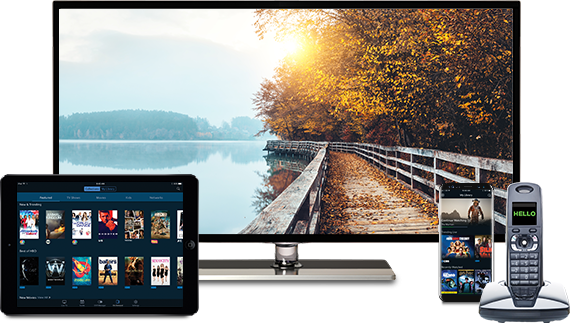Meet All Your Online Requirements with Cox Internet
Ample Data Allowance
Fiber-Powered
Experience Better Coverage With Cox Panoramic Wifi
Cox Internet packages are very carefully brought about to cater to individual needs. Be it a casual surfer or a committed gamer, Cox Internet plans with Panoramic Wi-Fi are for everyone to use. There is much more to Cox Internet packages than just basic services.
You deserve a reliable internet connection at home and that is just what you will get with Cox Panoramic Wifi. Work from home, take online lessons, or casually stream content, your internet will do it all.
- Exceptional Internet Coverage
- Accessible Through Mobile Apps
- Options For Data Limits
- Manage Your Wi-Fi Usage
- View 8k Video Streaming
Higher Speeds For Higher Value With Cox Internet Packages
Whether you’re in a large household or living independently, Cox Internet packages work for all. Not only would it be a great investment, but it ensures service satisfaction. Internet plans start at 100 Mbps and go up to 2 Gig. You can even see for yourself through the Cox Internet speed test. The connectivity levels are unmatched. Cox Internet is available in speed tiers, offering multiple budget packages to you.
With Cox Internet packages experience no lags or buffering while streaming or doing other internet activity. Get to experience smooth web browsing like never before.
- Reliable Internet Speeds
- Excellent Coverage
- 100 Mbps to 2 Gig
- Multiple Packages Available
Cox GIGABIT Fiber Internet Plans For The Fastest Internet Experience
Get to experience internet speeds of 1 and 2 Gig with Cox GIGABIT Fiber Internet plans. Allow yourself seamless surfing, streaming, gaming, and so much more. It’s time for you to upgrade your home devices with the fastest, most reliable internet service available. Enjoy gaming without lags, smoothly browse the internet, watch buffer-free streaming, and swiftly share heavy files. Home, work, or whatever, Cox GIGABIT Fiber Internet is for everyone who enjoys uninterrupted services.
With the Gigablast package, you get to experience top-tier internet services. An experience that will surely not disappoint you. With the option to connect multiple devices at once, experience great coverage with Cox internet packages. Once you upgrade to Cox GIGABIT Fiber Internet plans, there’s no going back for you.
- Connect up to 9 Devices
- Uninterrupted Connection
- Fastest Internet Speeds
- No More Lags And Buffering
Why Cox? Because it’s More than Just Fast Wifi!
Availability of Free Cox Wifi Hotspots
With Cox Internet, you get free and unrestricted access to over 4 million Wifi hotspots across the United States. If your region falls in a hotspot area, the Cox Internet package provides secure high-speed internet both inside your home and across America.
Money-Back Guarantee for the First 30 Days
No matter which Cox Internet package you choose, it will come with a 30-day money back guarantee offer. This means that if you are dissatisfied with the service, you may cancel it at any time within 30 days of installation/activation.
Complimentary McAfee Security Software
Cox Internet services feature antivirus protection that’s designed to keep you safe from a wide range of cyber threats. The Cox security suite is powered by McAfee® and can help users stay virus-free, buy safely, avoid identity theft, and more!
Cox Complete Care Offers Advanced Technical Support
You can add also Cox Complete Care for round-the-clock expert assistance to your package. With this provision, you can get your most difficult technical issues fixed remotely or on-site, whenever and wherever you need it.
Wall-to-Wall Wifi Coverage
Enjoy consistent Wifi signals throughout the house with Cox’s signature Panoramic Wifi gateway. Cox Wifi also comes with the Cox Panoramic Wifi app. This boasts a suite of assistance tools for managing your in-home Wifi networks.
Get Equipment Upgrades for Free
Not only does the Cox Panoramic Wifi automatically download the latest software upgrades on your network, but it also comes with the option for every customer to upgrade their equipment every three years.

Network and Data Security
Safeguard your devices against online threats with the Cox Security Suite. Opt for Panoramic Wifi to gain access to the Advanced Security package.

Complete Data at Your Disposal
Each plan offers a generous 1.25 terabytes (1280 gigabytes) of monthly data, and you can easily expand it if needed.

Comprehensive Coverage
The Panoramic Wifi Gateway harnesses the power of Wifi 6 technology to provide you with the most robust wifi signal.
Panoramic Wifi Like Never Before
Experience panoramic WiFi with Cox internet service. Enjoy seamless connectivity, reliability, and security – essentials for a great internet experience. Don’t settle for just speed; accessibility matters too. Imagine having dessert but being unable to taste it – knowledge alone isn’t enough. Mobile internet isn’t a reliable solution; it’s costly and drains your device’s battery. Cox Home Internet WiFi provides flexibility, connectivity, and mobility, accommodating multiple devices simultaneously. Cox’s Panoramic WiFi blankets your home, ensuring uninterrupted, wall-to-wall coverage, so you’re always connected, no matter your location in the house.

Experience the Distinctive Qualities of Cox Internet!
Maximize Productivity with a Dependable Network
The Cox Internet network’s unwavering reliability ensures the continuous operation of critical infrastructure around the clock. You can confidently rely on their state-of-the-art fiber-based network, backed by proven performance and cutting-edge technologies, to enhance your daily productivity and achievements. Trust Cox to be your most dependable network in all situations.
Speedier than 5G Home Internet
Experience faster and more dependable download speeds compared to 5G Home Internet, even during peak hours. Whether you’re working, learning, sharing, streaming, gaming, or chatting, you can enjoy a fully connected and uninterrupted home experience! Say goodbye to buffering and lag and welcome a seamless digital lifestyle that effortlessly adapts to your needs.

What’s So Good About Cox Internet deals?
Opt for Choices that Bring Peace of Mind
We provide hassle-free choices that allow you to select a plan and make adjustments whenever your need for speed evolves. Additionally, you can be confident that the price you see is Cox’s very best offer! This gives you peace of mind knowing that every penny spent is worth the service you get.
Gain Access to Cox GIG Internet in Your Area
High-speed internet has become an essential requirement in today’s world. Whether it’s for work or leisure activities, fast connectivity is now more crucial than ever. Cox takes pride in providing widespread access to gigabit download speeds through their Gigablast plan, available wherever they operate!
Customer Support That Goes Unmatched
Whether you require basic support or complex issue resolution, Cox’s outstanding support representatives are available to help you. From a lost connection, or a technical problem with your equipment, to any other issue that’s interfering with your Internet experience, the committed Cox customer care specialists respond quickly to client concerns.

Frequently Asked Questions
Is Cox Internet available in my area?
Cox is available in over 645 service areas, and you can access the Cox map to see if it is available in yours.
Is peacock-free with Cox internet?
Peacock is charged at $4.99 per month with Cox internet.
Why is my Cox internet not working?
If rebooting your router doesn’t work, you can get in touch with a Cox customer support agent via helpline, email, or chat to help you resolve your connectivity problems.
Can I just get Wifi from Cox?
Yes, you can select a Cox Internet only Wifi plan as per your speed and data preferences.
Is Cox internet down?
If you are experiencing a Cox internet outage, please call the helpline for further details.
How much is Cox internet?
The Cox internet cost for the starter package is $49.99.
Does Cox have internet plans for seniors?
Unfortunately, there is no senior citizen discount at Cox.
Is Cox Internet wireless or cable?
It is wireless.
Is Cox 4G or 5G?
Cox Mobile offers both 4G LTE and 5G nationwide, where it is available in your region.
Does Cox have fiber internet?
Cox relies on a hybrid and highly advanced coaxial cable network to function. It is powered by fiber optic to provide high speed.
Disclaimers
*Speeds are based on wired connections and may vary in your area.
**All monthly prices are for 12 months w/ 1-year service agreement.
Data Disclaimer:
All Cox Internet plans include 1.25 TB (1280 GB) per month of data usage. Additional Data Plans can be added for an additional monthly charge. Excess usage is $10 per additional 50 GB block, except for Unlimited Data Plan subscribers. Unused data does not rollover. For more details on data plans and data usage, see cox.com/dataspeedplans and cox.com/datausage.
About making changes to your plan
Additional services can be added at then-current regular rates. Rates and discounts subject to change when adjusting or removing services or equipment.
About making changes to your plan
Use of a Cox-approved DOCSIS 3.0 or higher cable modem is required for internet service. (Gigablast and Ultimate service require 3.1). WiFi equipment meeting the 802.11ac standard is required for optimal wireless Ultimate and Gigablast performance. For current download/upload speeds for all Cox Internet tiers, visit the Speeds and Data Plans page: https://www.cox.com/aboutus/policies/speeds-and-data-plans.html. Uninterrupted or error-free Internet service, or the speed of your service, is not guaranteed. Actual speeds may vary based on the type of equipment used, environmental and structural conditions in your home, number of users, and other factors. Maximum available speeds may vary depending on the service area. For more information on Cox Internet, see Cox Internet Service Disclosures: https://www.cox.com/aboutus/policies/internet-service-disclosures.html


